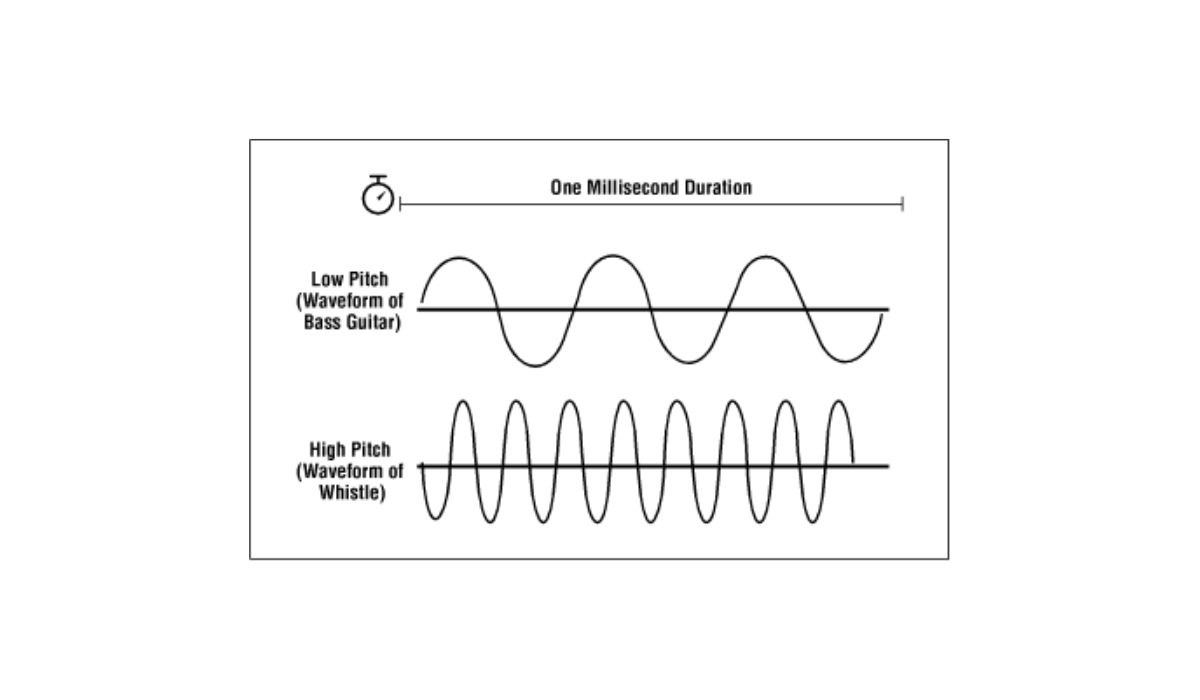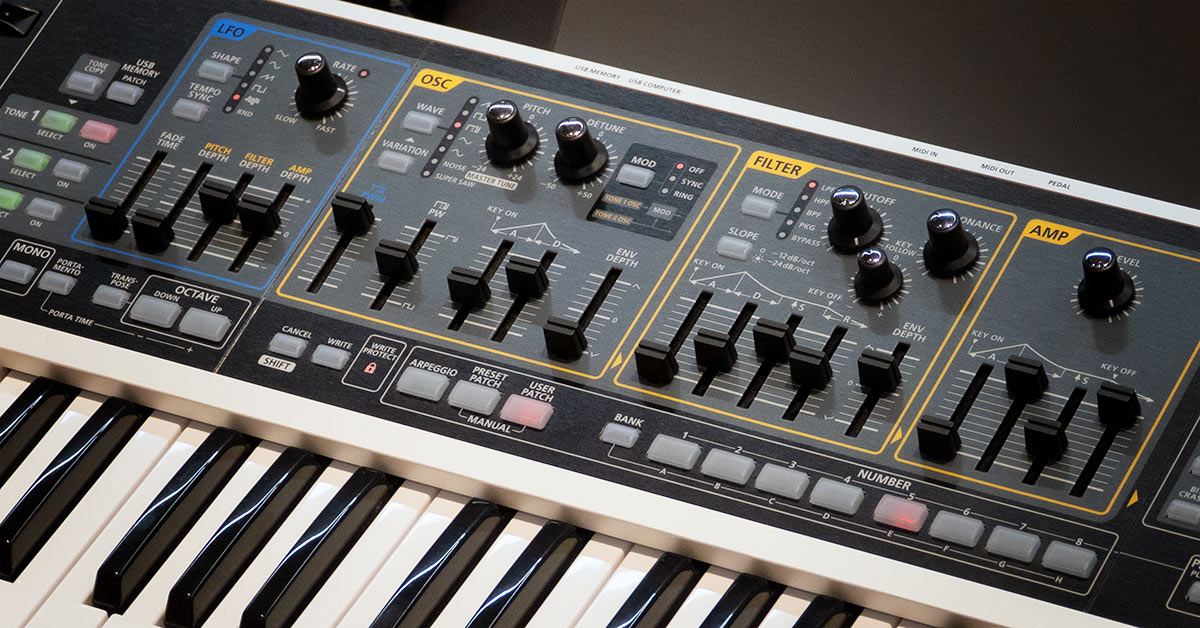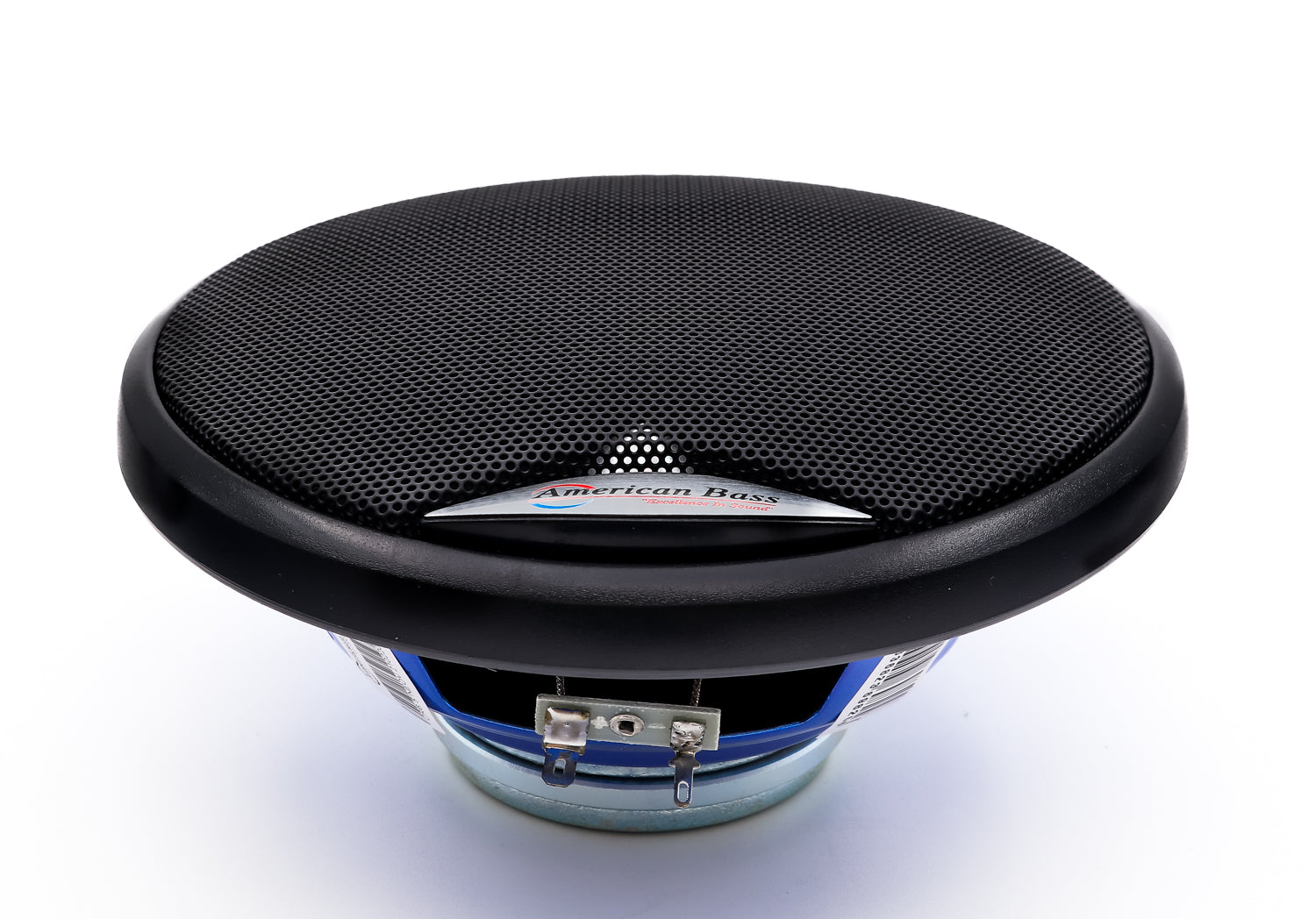Home>Production & Technology>Sound>What Determines The Pitch Of A Sound?


Sound
What Determines The Pitch Of A Sound?
Modified: February 24, 2024
Discover the factors that determine the pitch of a sound. Explore the science behind sound waves and how they contribute to the perception of different tones.
(Many of the links in this article redirect to a specific reviewed product. Your purchase of these products through affiliate links helps to generate commission for AudioLover.com, at no extra cost. Learn more)
Table of Contents
Introduction
Sound is an integral part of our everyday lives. Whether it’s the melodic notes of a favorite song, the rhythmic footsteps on a busy street, or the soothing sounds of nature, we are constantly surrounded by the phenomenon of sound. While our ears allow us to perceive sound, have you ever wondered what determines the pitch of a sound?
In this article, we will explore the fascinating world of sound and delve into the factors that contribute to the pitch of a sound. From the anatomy of sound to the intricate workings of our perception, we will uncover the secrets behind this fundamental aspect of auditory sensation.
Understanding the pitch of a sound is crucial not only for appreciating the complexities of music and language but also for various scientific and technological applications. From music production to speech recognition systems, a deeper knowledge of pitch can unlock new possibilities and enhance our understanding of the world.
So, join us as we embark on a journey through the realm of sound and discover the factors that shape the pitch we hear. By the end of this article, you will have a newfound appreciation for the interplay between vibrations, our ears, and our perception, and the influence they have over the sounds that surround us.
Anatomy of Sound
Before we dive into the concept of pitch, it’s important to understand the anatomy of sound. Sound is created when an object vibrates, creating waves that travel through the air or other mediums. These waves consist of compressions and rarefactions, which cause changes in pressure in the surrounding environment.
When these pressure changes reach our ears, they are captured by the outer ear, which funnels the sound waves into the ear canal. As the waves travel down the canal, they reach the eardrum, a thin membrane that vibrates in response to the incoming sound. This vibration is then transferred to the three tiny bones in the middle ear, known as the ossicles (the malleus, incus, and stapes).
The ossicles amplify the vibrations and transmit them to the fluid-filled cochlea, a spiral-shaped, snail-like structure in the inner ear. Within the cochlea, there are thousands of microscopic hair cells that are responsible for converting the mechanical vibrations into electrical signals. These signals are then transmitted to the brain through the auditory nerve, where they are interpreted as sound.
By understanding the intricate process of how sound travels through our ears, we can begin to unravel the factors that shape the pitch of a sound.
Frequency and Pitch
One of the fundamental concepts related to the pitch of a sound is frequency. Frequency refers to the number of vibrations, or cycles, that occur in a sound wave per second and is usually measured in hertz (Hz). The higher the frequency, the higher the pitch of the sound.
Think of a guitar string. When you pluck a thick guitar string, it vibrates more slowly, resulting in a lower frequency and a lower pitch. Conversely, when you pluck a thinner guitar string, it vibrates more quickly, producing a higher frequency and a higher pitch.
In general, humans can perceive sounds ranging from about 20 Hz to 20,000 Hz. The range of frequencies that humans can hear is called the audible spectrum. Sounds with frequencies below the audible spectrum are referred to as infrasound, while sounds with frequencies above the audible spectrum are known as ultrasound.
However, our ability to perceive pitch is not solely determined by the frequency of a sound wave. Other factors, such as the intensity and quality of the sound, also play a role in our perception of pitch.
Intensity, measured in decibels (dB), refers to the loudness of a sound. A louder sound tends to be perceived as having a higher pitch, even if the frequency remains the same. This is why a violin playing the same note as a trumpet may sound higher-pitched, as the violin usually produces a softer, lower-intensity sound compared to the trumpet. Intensity influences our perception of pitch by affecting the vibrations of the eardrum and the subsequent stimulation of the hair cells in the cochlea.
Furthermore, the quality or timbre of a sound can also influence the perception of pitch. Timbre refers to the unique characteristics of a sound that distinguish it from other sounds, even if they have the same pitch and intensity. For example, a piano and a guitar playing the same note will have different timbres, allowing us to differentiate between the two. The complex waveform of a sound, which is determined by the combination of different frequencies and their relative amplitudes, contributes to the perception of timbre and can influence how we interpret the pitch of a sound.
Understanding the relationship between frequency, intensity, and timbre is crucial to comprehending how pitch is perceived and experienced. By considering these factors, we can gain a deeper understanding of the complexities behind the pitch of a sound.
The Role of Vibrations
Vibrations play a crucial role in determining the pitch of a sound. When an object vibrates, it creates sound waves that travel through the air or other mediums. The frequency of these vibrations directly correlates to the pitch of the sound produced.
Imagine you strike a tuning fork. The metal prongs of the tuning fork vibrate rapidly back and forth. These vibrations create compressions and rarefactions in the air, resulting in the production of sound waves. The frequency of the tuning fork’s vibrations determines the pitch of the sound it produces.
As the frequency of the vibrations increases, so does the pitch of the sound. Similarly, when the vibrations decrease in frequency, the pitch becomes lower. This relationship between vibration frequency and pitch is consistent across various objects and instruments.
In musical instruments, different components vibrate to produce distinctive sounds with varying pitches. For example, in a guitar, the strings are plucked or strummed, causing them to vibrate. The length, thickness, and tension of the strings determine the frequency of their vibrations, and subsequently, the pitch of the sounds produced.
In wind instruments like the flute or trumpet, the pitch is influenced by the length of the air column inside the instrument. By changing the length of the column either through finger placement or valve adjustments, musicians can alter the pitch of the notes produced.
Vibrations are not limited to objects like musical instruments. They also occur within our vocal cords when we speak or sing. The pitch of our voice is determined by the rapid vibrations of the vocal cords. Higher pitch is produced when the vocal cords vibrate at a higher frequency, while lower pitch results from slower vibrations.
Understanding the role of vibrations in sound production allows us to appreciate the intricate relationship between frequency, pitch, and the objects or mechanisms that create the sounds we hear. This knowledge is essential in fields such as music, acoustics, and speech science, where pitch plays a critical role.
The Human Perception of Pitch
Our ability to perceive pitch is a remarkable aspect of human auditory perception. The ear acts as a complex machinery, translating sound waves into electrical signals that our brain can interpret. But how exactly do we perceive pitch?
The cochlea, a spiral-shaped structure in the inner ear, plays a crucial role in pitch perception. As sound waves enter the cochlea, they cause the fluid inside to move, stimulating the thousands of hair cells that line its walls. These hair cells are responsible for converting mechanical vibrations into electrical signals, which are then transmitted to the brain through the auditory nerve.
The specific hair cells that are activated depend on the frequency of the sound wave. Different regions along the cochlea are responsive to different frequencies, with lower frequencies stimulating hair cells towards the apex and higher frequencies towards the base. This tonotopic organization allows the brain to determine the pitch of a sound based on which hair cells are activated and to what degree.
However, our perception of pitch is not solely determined by the physical characteristics of the sound. It is also influenced by cognitive processes and previous experiences. Our brain combines incoming sensory information with our expectations and memories to create a subjective perception of pitch.
For example, if we hear a series of sounds with gradually increasing frequency, we perceive it as a continuous rise in pitch, even if the actual frequencies of the sounds are not linearly spaced. Our brain fills in the gaps and creates a sense of smoothness and continuity.
Cultural and environmental factors also impact our perception of pitch. Different cultures may have different musical scales and tonal systems, resulting in variations in how individuals perceive and interpret pitch. Moreover, exposure to different sounds and musical styles throughout our lives can shape our sensitivity and preferences for certain pitches.
It’s important to note that individuals can have variations in their pitch perception due to factors such as hearing impairments or neurological conditions. Pitch perception can be affected by factors like tinnitus or pitch perception disorders, which manifest as difficulties in accurately perceiving or distinguishing pitch.
Understanding the intricacies of human pitch perception is essential in fields such as music, speech therapy, and auditory neuroscience. By unraveling the mechanisms behind our perception of pitch, researchers can develop therapies and interventions to address pitch-related difficulties and enhance our understanding of auditory processing.
Factors Affecting Pitch Perception
While the frequency of a sound wave is a primary determinant of pitch, there are several other factors that can influence how we perceive pitch.
One important factor is the presence of harmonics or overtones. When a sound is created, it is often composed of multiple frequencies, known as harmonics, that are integer multiples of the fundamental frequency. These harmonics give a sound its unique timbre and can affect how we perceive the pitch. For example, if two sounds have the same fundamental frequency but different harmonic structures, they may be perceived as having different pitches.
Another factor is the context in which a sound is presented. Our perception of pitch can be influenced by the presence of surrounding sounds. For instance, the pitch of a tone played in isolation can be perceived differently when preceded or followed by other tones. This phenomenon, known as contextual pitch perception, highlights the complex nature of our auditory system and how it integrates various sensory inputs to interpret pitch.
Individual differences also play a role in pitch perception. Factors such as age, gender, and musical training can influence how we perceive and differentiate pitches. Studies have shown that musicians often have heightened pitch discrimination abilities compared to non-musicians, suggesting that musical training can enhance pitch perception skills.
Furthermore, the physical characteristics of the sound source can impact how we perceive pitch. For example, the size and shape of a musical instrument can affect the pitch perception of its sounds. Instruments with longer or larger resonating chambers tend to produce lower-pitched sounds, while smaller instruments or objects produce higher pitches.
Psychological and cognitive factors can also influence our perception of pitch. Our attention, focus, and expectations can shape how we perceive and interpret pitch information. For instance, if we are primed to expect a specific pitch based on prior auditory or visual cues, it can bias our perception of subsequent pitch stimuli.
It is worth mentioning that pitch perception can be susceptible to various impairments, such as congenital amusia (tone deafness) or acquired pitch disorders. These conditions can impact an individual’s ability to accurately perceive and discriminate between pitches, leading to difficulties in music perception and production.
Understanding the complex interplay of these factors that affect pitch perception is crucial for researchers, musicians, audiologists, and others working with auditory processing and perception. By considering these factors, we can gain a deeper understanding of the nuances of pitch perception and develop strategies to enhance our auditory experiences and abilities.
Musical Instruments and Pitch
Musical instruments play a crucial role in the production and manipulation of pitch. Each instrument has a unique design and mechanism that allows for the generation of specific pitches and timbres.
Stringed instruments, such as the guitar, violin, or piano, produce pitch by plucking or striking strings that are stretched and tensioned across their bodies. The length, thickness, and tension of the strings determine the frequencies at which they vibrate, thus influencing the pitch of the notes produced. By pressing the strings against frets or keys, musicians can effectively change the length and therefore alter the pitch being produced.
Wind instruments, on the other hand, generate pitch through the manipulation of air columns. Examples of wind instruments include the flute, trumpet, and saxophone. The pitch produced by these instruments is mainly influenced by the length and shape of the air column, as well as the force and speed at which the musician blows into the instrument. By adjusting finger placements or valve positions, musicians can change the effective length of the air column and produce different pitches.
Percussion instruments, like drums or xylophones, do not produce pitch in the same way as stringed or wind instruments. Instead, they create sounds with varying timbre and intensity. However, pitch can still be manipulated in certain percussion instruments, such as the timpani or marimba, where the size, tension, or material of the drumheads or bars determine the pitch of the produced sounds.
Combining different instruments and their unique characteristics allows for the creation of harmonies, melodies, and chords. The interaction between instruments in an ensemble or orchestra results in a complex interplay of pitches, creating the rich and diverse musical compositions we enjoy.
It is worth mentioning that some instruments, such as the piano or the guitar, can be tuned to specific pitches or temperaments, which refer to the organization of intervals between the successive notes of a scale. The choice of tuning affects the overall sound and character of the instrument, and thus has a direct impact on the perception and interpretation of pitch in music.
Understanding how musical instruments produce and manipulate pitch is crucial for musicians, composers, and musicologists. It enables them to make informed choices in creating and arranging musical compositions, and contributes to their mastery of playing techniques and expression.
Pitch and Language
Pitch is not limited to the realm of music; it also plays a significant role in language. In spoken communication, pitch variations contribute to the expression of meaning, emphasizing certain words or conveying specific emotions or intentions.
One way in which pitch is utilized in language is through intonation. Intonation refers to the rise and fall of pitch patterns within a sentence or phrase. It helps convey the intended meaning and adds nuance to our spoken words. For example, a rising pitch at the end of a sentence can indicate a question, while a falling pitch can convey a statement or assertion.
Intonation patterns can also demonstrate emotional states or attitudes. A rising pitch may indicate surprise, excitement, or uncertainty, while a falling pitch may convey seriousness, confidence, or finality. By using pitch variations, speakers can add richness and intention to their words, making their communication more engaging and effective.
The role of pitch in language extends beyond intonation. In some languages, such as Mandarin Chinese, pitch differences can lead to variations in the meaning of individual words. These languages are pitch-tonal, where different pitches or pitch contours distinguish between words that would otherwise be pronounced exactly the same. Mispronouncing the pitch pattern can lead to misunderstandings or confusion.
Furthermore, pitch can contribute to the perception of gender in spoken language. Studies have shown that individuals tend to associate higher pitch with femininity and lower pitch with masculinity. This association can influence social perceptions and expectations, leading to certain stereotypes or biases related to gender roles.
It is also worth noting that pitch can affect our interpretation of speech in noisy environments. Higher-pitched voices tend to have greater prominence in noisy backgrounds, as high frequencies have better resistance to noise interference. This can influence our ability to comprehend speech and discriminate between different speakers in challenging acoustic conditions.
Understanding the role of pitch in language is important for effective communication, public speaking, and accent modification. By developing awareness and control over pitch variations, individuals can improve their vocal delivery, convey their intended meaning more clearly, and enhance their overall communication skills.
Conclusion
Pitch is a fundamental aspect of sound that influences our perception and experience of the world around us. Whether it’s the melodies of music, the cadence of spoken language, or the vibrations of everyday sounds, understanding the factors that determine pitch enhances our appreciation and comprehension of auditory phenomena.
We have explored the intricate relationship between frequency and pitch, recognizing that frequency alone does not fully account for our perception of pitch. Factors such as intensity, harmonics, context, and individual differences play crucial roles in shaping how we perceive and interpret pitch information.
From the anatomy of sound and the role of vibrations to the complexities of human perception, we have uncovered the remarkable mechanisms that contribute to our understanding of pitch. Musical instruments serve as tools for manipulating and expressing pitch, while language utilizes intonation and pitch variations to convey meaning and emotion.
Our perception of pitch is not only influenced by the physical properties of sound but also by cognitive processes, cultural factors, and personal experiences. Awareness of these influences allows us to navigate the multifaceted nature of pitch perception and appreciate its nuances in different contexts.
By delving into the realm of pitch, we gain insights into fields such as music, speech and language, psychology, and auditory neuroscience. This knowledge enriches our understanding of how sound is produced, perceived, and used in various aspects of our lives.
In conclusion, pitch is a complex and fascinating phenomenon that adds depth, expression, and meaning to the sounds we encounter. Developing a deeper understanding of pitch allows us to harness its power in creative endeavors, improve our communication skills, and unravel the mysteries of our auditory perception.











